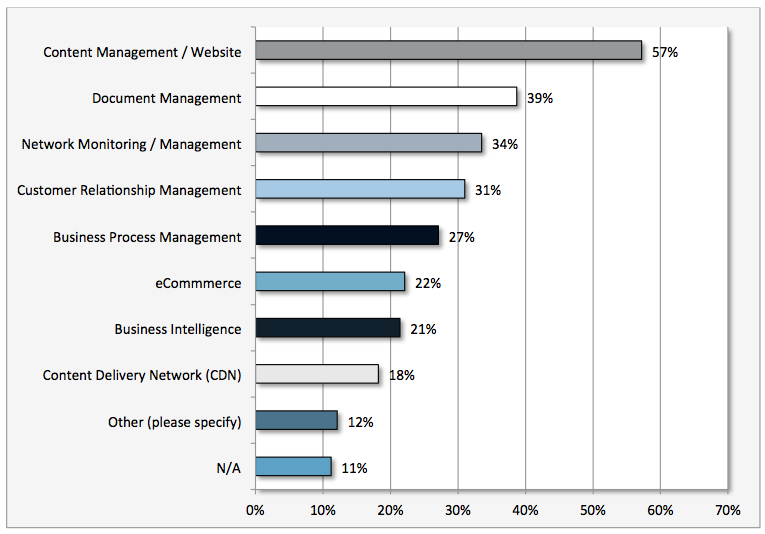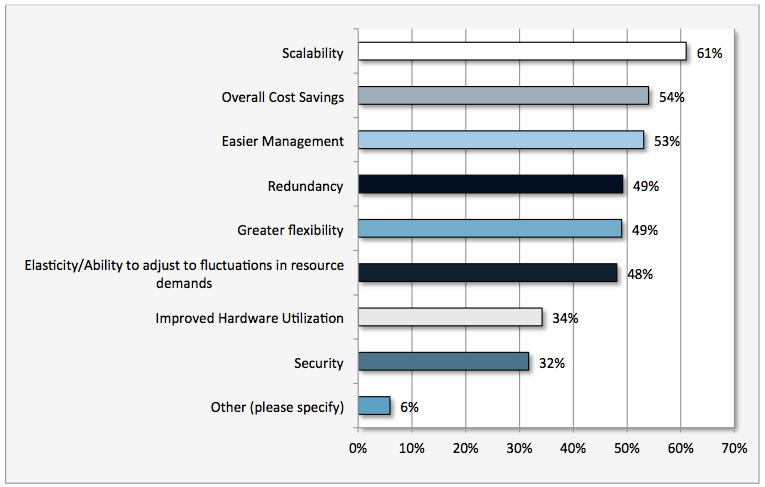Cloud.com, BitRock, and Zenoss have surveyed more than 500 members of the open source and systems management community about trends in cloud computing and users’ preferences and plans. The result? There’s a strong correlation between open source and cloud usage — and the survey found that Linux looms large in plans for deployments.
The survey was taken by 521 IT professionals in a broad variety of institutions, with 9% working for public companies, 51% working for private / privately-held companies, 11% working in educational institutions, 5% in government, and 4% at non-profits. The respondents range from CTOs (11%), IT managers (18%), to technical support (7%) and developers (12%).
Planning for cloud infrastructure varies widely, with only 7% having an “approved cloud computing strategy,” and 20% with “no plans to develop” a cloud computing strategy. About 44% of the respondents have at least a partial or fully developed strategy for cloud computing and — good news for the marketing folks — 32% are still gathering input for their 2011 cloud computing strategy. (Though the survey was run earlier this year, so it may well be that the ones gathering input earlier in the year are now finished.)
Interesting Results
Now that we have a profile of the people responding, let’s take a look at the results. One of the most interesting, here at Linux.com at least, is the OS that respondents plan to run. Overwhelmingly, Linux was on the shopping list for 83% of the respondents — compared to 66% for Windows, 8% looking to BSD, only 5% for Solaris, and 12% choosing “other.” Naturally, many shops are looking at mixed deployments to satisfy needs for applications that run only on Linux or Windows, but it’s clear from the survey that Linux is doing quite well.
Not just Linux, of course, open source is doing quite well too. Most organizations (69%) plan to use open source “whenever possible,” and only 3% of the organizations are against using open source in the cloud.
What do organizations want to do with all this open cloud Linux-based goodness? Right now there’s a fairly even mix of plans to use cloud computing for compute (59%), storage (51%), or Platform as a Service (Paas) with 47%.
Application choice for the cloud shows strong interest in content management and Web publishing (57%), document management (39%), and network monitoring and management (34%). See Figure 1 for the chart of results.
 The majority of organizations want to run cloud computing on their own hardware, with 57% of the respondents wanting to use their own hardware and facilities. Only 18% wanted to use dedicated hardware at a managed service provider, and 23% of the organizations want to use their own hardware at a service provider using a shared infrastructure.
The majority of organizations want to run cloud computing on their own hardware, with 57% of the respondents wanting to use their own hardware and facilities. Only 18% wanted to use dedicated hardware at a managed service provider, and 23% of the organizations want to use their own hardware at a service provider using a shared infrastructure.
The Whys and Hows of Cloud Computing
Why are organizations turning to cloud computing? The reasons are varied, and most organizations have a number of reasons for wanting to use cloud computing. The top reason, at 61%, is scalability. Scalability is followed closely by cost savings (54%), and ease of management (53%).
My favorite reason, redundancy, came in fourth with only 49% of respondents. Greater flexibility also came in at 49%, and elasticity was right there with 48%. It’s a bit surprising that elasticity isn’t higher on the list, given that scalability features so highly. You’d think that the two go hand-in-hand, with a need to meet fluctuating demand. See Figure 2 for the full results.
The organizations also have some notions about what the cloud is good for. Though only 54% listed cost savings as a reason for cloud computing, 68% believe it will save on hardware costs, and 66% believe it will be faster to deploy infrastructure. And 57% say that it will reduce the burden of systems management. Though less than half of the respondents cite elasticity as a reason for choosing the cloud, 51% say that elasticity is a benefit of cloud computing.
It doesn’t look like most of the organizations are depending too heavily on cloud computing just yet. Many of the organizations (61%) plan to use the cloud for development and testing. Far behind development comes Software-as-a-Service (SaaS), with 37% of the organizations planning to use the cloud to offer SaaS. Note that doesn’t measure the companies that want to use SaaS that’s hosted in the cloud. A third (33%) of the organizations want to use cloud computing to mimic public cloud services behind their firewall, and just 27% want to use cloud computing for High Performance Computing (HPC).
Hesitation
Cloud computing does have some hurdles to overcome. A lot of respondents are worried about the security of the cloud, and inertia (otherwise known as a “conservative IT strategy”) is in the way for 30% of organizations. The lead inhibitor, though, is training — 43% of organizations see a lack of cloud training as a problem for deploying cloud computing.
It’s also worth noting that regulatory compliance is cited by more than 20% of the organizations. That’s worth paying attention to for those companies supplying solutions related to cloud computing. No doubt regulatory compliance features highly on the list of the 9% of public companies that are mulling cloud computing.
Security is also seen as a challenge for management in the cloud with 36% of users saying that security is a headache, while only 12% cited said that performance management is a problem. Configuring guest instances is only a challenge for 10% of the users, and provisioning Linux instances came in dead last at 7%.
Finally, a whopping 53% say that their existing systems management tools do not translate well for managing their cloud computing environment. Something to pay attention to for systems management vendors.
Summary
If you’re hoping to make use of the survey in your own work, note that the survey results are provided under the Creative Commons Attribution 3.0 Unported (CC BY 3.0) license.
The bottom line? It looks like cloud computing is following a typical adoption pattern. Organizations are finding out what cloud computing is food for, and not. Naturally, Linux is featuring significantly in most organizations plans for cloud computing — as is open source software.
Does this fit your expectations? Tell us in the comments how your organization is using Linux and cloud computing!

